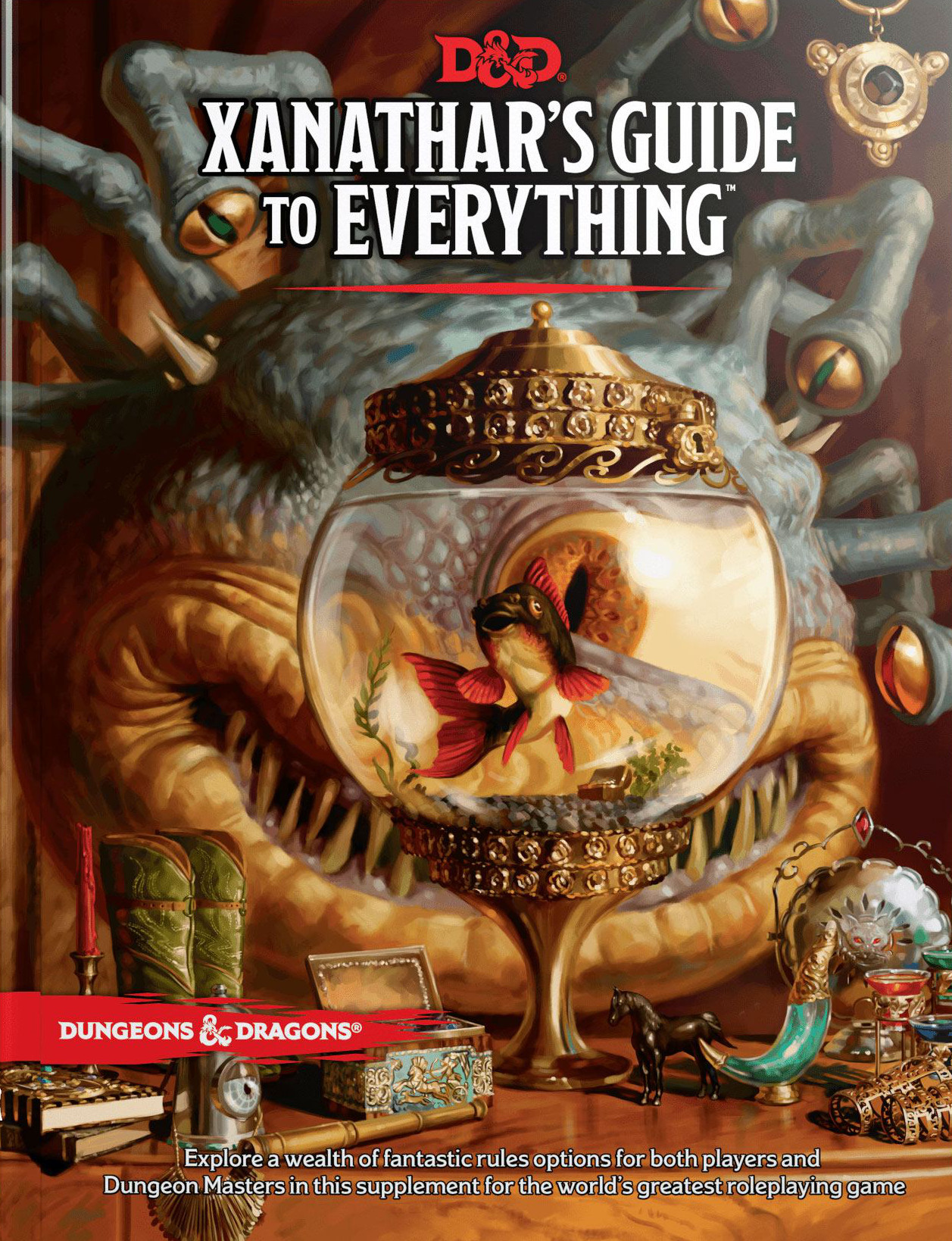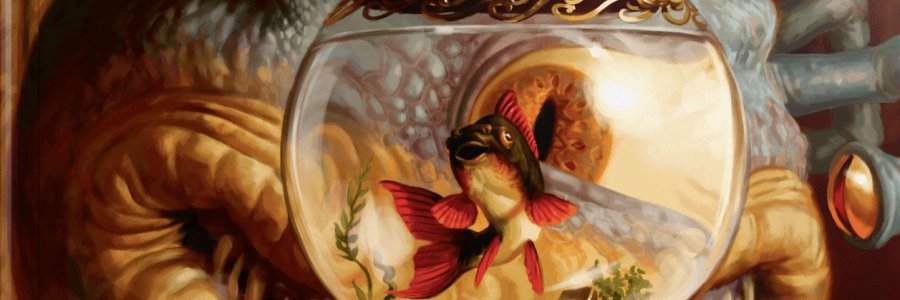
The D&D 5th Edition core books are like comfort food: easy to consume and recommend. The campaign books are like large, multi-course meals; you may not love everything in them, but there's a lot to get through and it's almost always thoughtfully assembled.
The new Xanathar's Guide to Everything is an assortment of chocolates. Nothing here will revolutionize your campaign, but it's all tasty, and there's a good chance of some little morsel you'll remember for years.
Xanathar's is a collection of extra options for players and DMs. A lot of options.
Player Options
After one page clarifying some 5th Edition rules that the designers apparently get a lot of questions about, like the timing of reactions and the order in which to apply resistances, the book provides a variety of...let's just call them sub-classes. These are the "class options" that PCs can take at level 3. Sorcerers can now call on Shadow Magic or Storm Magic, monks can be Drunken Masters, and so forth. It's not evenly distributed; paladins only get two new sub-classes, while rogues get four. This is actually a good sign, as they didn't attempt to fill out each set artificially.
The sub-classes all feel like useful additions to the game; ideas that players have been requesting or home-brewing.
Each class also gets several tables that round out the class's flavor and background; paladins can have a nemesis and temptation, and druids can roll for a guiding aspect of nature and details on the druid's mentor. Each class gets 3 to 4 of these, and they do help to drill down into the core of a character concept.
This is followed by, to my surprise and delight, a simple life path system. It's basically a set of tables you roll on to decide elements of your character's backstory (composition of family, status of parents, and life events), including a set of tables for each background explaining why you ended up with that particular background or some other deeper motivation. For example, the noble's family might have recently come by their title, or have a colorful history the PC is trying to live up to, or may be disgraced.
This strikes me as a really useful tool for learning more about your character's motivations and goals.
DM Options
Then, after two pages of extra feats, we move to the GM section of the book, at only page 77 out of 190. That's right: two thirds of this book is dedicated to DMs.
This section begins by clarifying some other rules that have apparently been a little unclear (such as how to resolve simultaneous actions) and adding some new options, such as exhaustion from lack of sleep. Several pages helpfully describe each toolkit in the game in detail (alchemist's supplies, mason's tools, and so forth), describing how it's helpful for certain checks, Difficulty Classes for those checks, and examples of use.
I'll get use out of this. For my players, their herbalism kit or calligrapher's supplies just sit on their character sheet, unused, because they're not sure what's in it. Now I can tell them.
There are several pages on building encounters, mainly collecting the kind of advice you'd find on a decent Reddit thread or blog post, following a simple order:
- Assess the Characters (figure out what will challenge the PCs)
- Choose Encounter Size
- Determine Numbers and Challenge Ratings
- Select Monsters
- Add Flavor (monster personality and relationships).
Unfortunately, it relies on Challenge Ratings, which I find too coarse to be effective. However, much of the other advice is welcome, particular the monster personality. A greedy monster will behave very differently than a bully or a coward.
But after that, you get 20 pages of monster encounters, divided by terrain and level, built as a set of tables. Are your 7th-level PCs going through a forest? Flip to the "Forest Encounters (Levels 5-10)" table on page 99 and choose an option, or roll d100. Examples include 1d4 giant boars, 1 bandit captain with 1 druid and 1d6+5 bandits, or 1 young green dragon.
I love this because it gives the struggling DM an easy way to come up with a combat encounter. A single table of random enemies by level isn't helpful, because you're not going to find a frost giant in a desert.
Even further, one of these encounters can inspire more material for the composition of your world. Why are the bandits in this part of the forest? Where does the adult blue dracolich lair?
Then, ten pages about how to make simple and complex traps. This feels less useful to me, as the book lists only 9 simple traps (all of them classics like a poison needle trap and a scything blade) and 2 complex traps, but maybe I need to up my trap game here. Traps just seem pretty straightforward to me.
After that, the book lists pages of potential downtime activities, helping to flesh out the parameters around projects like in-depth research, creating a spell scroll, or crafting an item. This is very welcome for groups who want to make those parts of the game feel more weighty and interesting, and there's enough detail here to give the DM plot hooks and specific numbers for Difficulty Classes and gold costs.
Before I go on, a quick mention of the marginalia by Xanathar, a long-standing Beholder character in D&D's Forgotten Realms who operates a crime organization. His notes, while cute and helpful in revealing a Beholder's thought processes, add nothing else substantive to the book. It's fun, but the book would be just as useful without them.
In any event, after the downtime activities you get some advice on handing out magic items, and a few pages that will come as welcome relief to a lot of DMs: a set of tables cataloguing all the magic items in the Dungeon Master's Guide. No more scanning through dozens of pages for magic items tagged "rare."
We're nearing the end of the book, and weirdly, we get a section for both DMs and players: 25 pages of new spells. While welcome and well-presented, including lists at the beginning of the chapter of all the new spells for each class, I wonder why this wasn't sandwiched between the player and GM sections of the book.
After a few pages with advice on shared campaigns, the book ends with one of its most useful features: tables of names for characters. Both players and DMs will likely get use out of this, as the names all feel reasonable and useful, and there's a good variety of tables from many different cultures.
Sadly, there's no index.
What if you're not playing D&D 5th Edition? There's quite a bit of useful information here, especially the character background tables, downtime activities, tables of monsters by terrain, and tables of names. The trap advice might be useful, too. I can't recommend it unreservedly to players of, say, Dungeon World, especially at USD $30-$50, but I definitely recommend flipping through it in a bookstore if you get a chance.
All in all, Xanathar's is a genuinely useful set of tools, primarily for a D&D 5th Edition group, but also for players of other fantasy RPGs.


![[Atom feed]](/user/themes/geek-archaeology/images/atom-feed.png)
![[RSS feed]](/user/themes/geek-archaeology/images/rss-feed.png)
![[iTunes podcast feed]](/user/themes/geek-archaeology/images/itunes-feed.png)